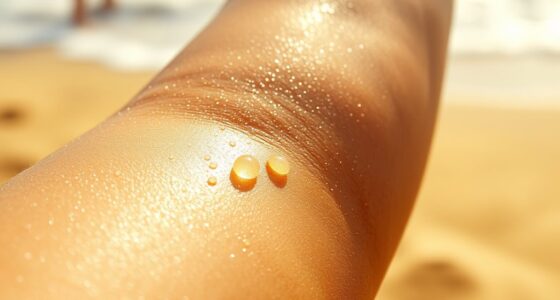Natural tanning isn't safer than indoor tanning. Both expose your skin to harmful UV radiation, which can considerably increase your risk of skin cancer. About one in five Americans will develop skin cancer by age 70, and tanning before age 35 raises melanoma risk by 75%. A tan is actually a sign of skin damage, not health. While some myths suggest moderation makes tanning safe, that's far from the truth. To better understand the risks and safer alternatives, you'll want to explore more about tanning choices and protection methods.
Key Takeaways
- Natural tanning significantly increases skin cancer risk due to harmful UV radiation exposure, similar to indoor tanning methods.
- Both natural sunlight and tanning beds emit UV rays that lead to DNA damage and long-term skin health issues.
- Myths like "moderation is safe" or "base tans offer protection" are misleading; all tanning indicates skin injury.
- Adequate vitamin D can be obtained from minimal sun exposure, diet, and supplements, reducing the need for tanning.
Understanding Natural Tanning Risks
When you spend time in the sun to achieve a natural tan, you're exposing your skin to harmful UV radiation that greatly increases your risk of skin cancer. In fact, studies show that starting tanning before age 35 can raise your chances of developing melanoma by 75%. Just one blistering sunburn during your youth can double this risk, emphasizing the dangers of significant sun exposure.
Tanned skin is a visible sign of DNA damage, as your body reacts to UV exposure by producing more melanin. This process doesn't protect you from further skin damage; in fact, it often leads to premature aging, manifesting as wrinkles, dark spots, and leathery skin over time. You might think a natural tan looks healthy, but it's a clear indicator of the harm being done beneath the surface.
Public health guidelines underscore the importance of sun protection, stating there's no safe level of UV exposure. By understanding these risks, you can make more informed decisions about tanning and prioritize skin health over aesthetics.
Comparing Natural and Indoor Tanning

Natural tanning and indoor tanning both expose your skin to harmful UV radiation, but they differ markedly in their risks and effects on skin health.
Natural tanning involves sun exposure that emits both UVA and UVB rays. While this can lead to some melanin production, it still results in DNA damage in your skin cells.
Indoor tanning beds primarily emit UVA rays, which can be 10-15 times more intense than natural sunlight, greatly increasing your risk of skin cancer.
Using tanning beds can elevate your chances of developing melanoma, a serious form of skin cancer. A single blistering sunburn from natural tanning can double that risk, highlighting the dangers of both methods.
Many people mistakenly believe that achieving a base tan offers adequate protection against sunburn and skin damage, but this perception is misleading.
Ultimately, whether you choose natural or indoor tanning, the tanning risks remain substantial. It's vital to educate yourself on the dangers associated with both methods to make informed decisions about your skin health.
Prioritizing protection from UV radiation is important for preventing long-term skin damage and reducing the risk of skin cancer.
Myths About Tanning Safety

Many people mistakenly believe that tanning, whether from the sun or a bed, is safe if done in moderation, but this couldn't be further from the truth. Both natural and indoor tanning expose your skin to harmful UV radiation, greatly increasing your risk of skin cancer, including melanoma. If you start tanning before age 35, you face a staggering 75% higher risk of developing this deadly form of skin cancer.
One common myth is that a 'base tan' can protect you from sunburn. In reality, it only offers the equivalent of SPF 3, indicating that your skin is already undergoing DNA damage. Tanning beds are even more dangerous, emitting UV rays that are 10-15 times stronger than sunlight, amplifying the risks of skin damage.
Despite societal beliefs that a tanned appearance is healthy, any tan is simply a sign of skin injury. This reinforces the importance of effective sun protection strategies.
Skin Type and Tanning Effects

Understanding your skin type is key to recognizing how tanning affects you and the associated risks of skin damage. Your skin type can determine how well you tan and your susceptibility to issues like sunburn and skin cancer. Here's a quick overview of skin types and their tanning effects:
| Skin Type | Tanning Effects |
|---|---|
| Type I | Always burns, high risk of skin cancer |
| Type II | Burns easily, moderate risk of skin cancer |
| Type III | Tans gradually, some risk of sunburn |
| Type IV | Tans easily, lower risk of skin cancer |
| Type V | Rarely burns, minimal risk of skin cancer |
While melanin levels in darker skin provide some protection, it doesn't make you immune to the dangers of UV exposure, DNA damage, and photoaging. The cumulative effects of tanning can lead to significant skin damage over time for all skin types. It's vital to adopt protective measures, such as using sunscreen and limiting sun exposure, regardless of your skin type. Remember, a tan is a sign of skin damage, and awareness of your skin type can help you make informed choices about tanning.
The Truth About Vitamin D

Tanning might seem like a quick way to boost your vitamin D levels, but the reality is quite different. Tanning beds primarily emit UVA rays, which don't help your body produce vitamin D. Instead, UVB rays are responsible for that.
You can actually get enough vitamin D from just a few minutes of sun exposure on your face and hands without resorting to tanning. Moreover, excessive UV exposure, whether from tanning beds or natural tanning, increases your risk of skin cancer without providing any additional benefits for vitamin D.
Public health guidelines encourage you to adopt safe sun practices, emphasizing that you can maintain adequate vitamin D levels through dietary sources like fatty fish and fortified products. Supplements are another effective option if you're concerned about your intake.
Long-Term Consequences of Tanning

When you tan, you're not just changing your skin's color; you're also putting it at risk for long-term damage.
Over time, this exposure can lead to premature aging, an increased risk of skin cancer, and irreversible DNA damage.
Understanding these consequences can help you make more informed choices about your tanning habits.
Skin Aging Effects
Regular exposure to UV radiation damages your skin's DNA, leading to wrinkles and age spots that worsen over time. When you tan, your skin is reacting to UV exposure, indicating underlying skin damage. This process contributes to accelerated skin aging, making you appear older than you are.
The cumulative effects of tanning can result in leathery skin, as UV radiation depletes skin elasticity and alters its texture. Studies show that indoor tanning can visibly age your skin even faster than natural sun exposure, leading to a higher incidence of premature skin damage. Over time, you may notice more pronounced wrinkles and age spots, which are signs of the damage your skin has sustained.
Moreover, habitual tanning increases the risk of nonmelanoma skin cancers, highlighting the long-term consequences of your choices. Protecting your skin from UV exposure not only helps maintain a youthful appearance but also reduces the risk of serious skin issues down the line.
Cancer Risk Increase
Exposing your skin to UV radiation, whether from the sun or tanning beds, considerably heightens your risk of developing skin cancer over time. Studies reveal that even one blistering sunburn can double your risk of melanoma, one of the deadliest forms of skin cancer. If you start tanning before age 35, your chances of developing melanoma increase by a staggering 75%.
Both natural tanning and indoor tanning expose you to harmful UV radiation, which the World Health Organization classifies as a carcinogen. This classification underscores the serious risks associated with tanning, as long-term exposure leads to cumulative damage, resulting in various skin cancers, including basal cell carcinoma and squamous cell carcinoma.
Unfortunately, the statistics are alarming: about one in five Americans will develop skin cancer by age 70. This stark reality highlights the long-term consequences of tanning behaviors.
DNA Damage Accumulation
Tanning, whether from the sun or a tanning bed, inevitably leads to DNA damage in your skin cells, setting the stage for serious long-term health consequences. Each session exposes your skin to harmful UV radiation, resulting in cumulative skin damage that can manifest as skin cancer.
| Long-Term Effects | Description |
|---|---|
| DNA Damage | UV radiation causes DNA injury, leading to mutations. |
| Skin Cancer Risk | Increased risk of melanoma by 75% for early tanners. |
| Skin Aging | Accelerated aging, including wrinkles and age spots. |
| Melanin Production | Tanned skin indicates melanin's protective response to UV exposure. |
When you tan, your body produces melanin as a defense mechanism, but this is merely a sign that DNA injury has occurred. Over time, persistent UV exposure can lead to irreversible changes in your skin DNA. Don't underestimate the long-term effects of tanning; they can dramatically increase your risk of skin cancer and contribute to premature skin aging. Protecting your skin now can save you from the dire consequences later.
Protecting Your Skin Effectively

Effective skin protection starts with using a broad-spectrum sunscreen that has an SPF of at least 30. This protects you from harmful UV radiation, which can lead to skin cancer and significant skin damage. Make sure to reapply your sunscreen every two hours, or immediately after swimming or sweating, to maintain effective coverage.
In addition to sunscreen, wearing protective clothing—like wide-brimmed hats and UV-protective garments—can help reduce direct sun exposure. It's also wise to seek shade during peak UV hours, typically between 10 a.m. and 4 p.m. This minimizes your risk of sunburn and long-term skin issues.
While you're focused on protection, don't forget about your vitamin D levels. You can maintain them by getting safe sun exposure or considering dietary supplements. Regular skin checks for any changes or irregularities are essential for early detection of skin problems, enabling timely intervention if necessary.
Mental Health and Tanning Misconceptions

Many people mistakenly believe that getting a tan can enhance their mood, but the risks of UV exposure far outweigh any temporary feelings of well-being.
While it's true that tanning can increase serotonin levels, the long-term consequences include skin damage and a heightened risk of skin cancer. This misconception often leads to compulsive behavior, known as 'tanorexia,' where individuals feel anxious or depressed without UV exposure.
Instead of turning to tanning for a mood boost, consider healthier alternatives. Engaging in regular exercise, spending time with friends, or exploring hobbies can provide significant mental health benefits without the risks associated with UV exposure.
Light therapy is another effective option for those dealing with Seasonal Affective Disorder (SAD), offering a safe way to enhance your mood without damaging your skin.
Making Informed Tanning Choices

When considering your options for achieving a tan, it's crucial to weigh the risks associated with UV exposure against the benefits of safer alternatives.
Natural tanning, whether from the sun or tanning beds, subjects your skin to harmful UV radiation, greatly increasing your risk of skin cancer. Just one blistering sunburn in your youth can double your chances of developing melanoma later in life.
Tanning beds are particularly dangerous, emitting UV radiation that's 10-15 times more potent than sunlight. Even a base tan offers minimal protection against sunburn, equivalent to only SPF 3, which is far from sufficient. The cumulative damage from any UV exposure can lead to long-term skin issues, such as premature aging and heightened cancer risk.
Instead of risking your skin health, consider safe alternatives like self-tanning products. These options allow you to achieve that bronzed look without exposing yourself to harmful UV rays or increasing your likelihood of sunburn.
Frequently Asked Questions
Can You Naturally Tan Safely?
You can't naturally tan safely without risking skin damage and increasing your chances of skin cancer. Even minimal sun exposure harms your skin, so consider safer alternatives like self-tanning products for a bronzed look without health risks.
Is Natural Sun Tanning Safe?
Natural sun tanning isn't safe. The risk of skin cancer increases with UV exposure, even with short periods in the sun. Always use sunscreen with at least SPF 30 to protect your skin from harmful effects.
Is There Any Tanning That Is Safe?
There's no tanning method that's completely safe. Any form of UV exposure damages your skin and increases cancer risk. Instead, consider safer alternatives like self-tanners for a bronzed look without harming your skin.
Are the Newer Tanning Beds Safer?
When it comes to newer tanning beds, don't let their shiny promises fool you. They still emit harmful UV rays, increasing your risk of skin cancer. Ultimately, no tanning bed is truly safe for your skin.
What are the potential risks of natural tanning compared to using a base tan for protection?
When it comes to tanning, it’s important to learn about base tans. While natural tanning may seem harmless, it carries potential risks such as sunburn, premature aging, and increased risk of skin cancer. Using a base tan for protection can provide a safer alternative by offering some degree of UV protection.
Conclusion
In the end, understanding the risks of natural tanning is like maneuvering through a maze—each turn can lead to unexpected consequences.
While the sun may seem inviting, it's crucial to protect your skin and make informed choices.
Don't fall for myths that downplay the dangers; instead, prioritize your health.
Remember, a golden glow today could lead to long-term damage tomorrow.
Embrace sun safety, and keep your skin radiant without sacrificing your well-being.









